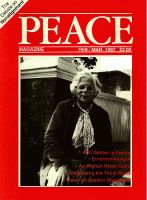
Peace Magazine Feb-Mar 1987, page 7. Some rights reserved.
Search for other articles by Martin Zeilig here
IN 1967 COLE SUMMERS WAS A YOUNG man on the verge of joining the United States Marine Corps. An expert rifle shot, Summers thought that he would make an excellent "sniper." Luckily, though, a chance to play football at a junior college in the State of Washington intervened, and the curly-haired athlete from Winnipeg headed south to training camp rather than to boot camp. It was three years later, after having transferred to Portland State University in neighboring Oregon, that an event occurred which, as Summers says, "changed my life."
The murder, by National Guardsmen, of four innocent students at Kent State University in Ohio who were nonviolently protesting against the war in Vietnam resulted in spontaneous demonstrations on college campuses across America. At Portland State the students organized a sympathy strike in a nearby park. The gathering was brutally suppressed by local authorities. Cole Summers witnessed the "massacre" at his school.
"Police went crazy" as they beat, pummelled, and smashed their way through the striking students and their supporters. In their wake was a moaning trail of battered and bloodied young people. Summers remembers with disgust how many of his fellow "jocks," from the safety of their dormitory windows, encouraged the police actions with shouts of "Kill the hippies!"
Prior to that experience, Summers had befriended a number of Vietnam vets who were against the war. He attended debates on the issue, and had begun to develop a more critical attitude toward American involvement in Southeast Asia. However, it was that one awful afternoon in May, 1970 which made him realize that sports and athletes cannot remain separate from the social problems of the day.
After graduation, Summers returned home to Winnipeg. He quickly gained a reputation as a qualified fitness instructor who specialized in teaching women self-defence. Though he is opposed to violence, Summers feels that those who are the most victimized in society, such as women, ought to know the basics of self-defence, "It's only common sense," he contends. Memories of helpless students and rioting police in Portland reinforce that conviction.
The election of Ronald Reagan in 1980 was like a catalyst to peace activists everywhere. Cole Summers started wondering what the use of training all these athletes was if "the world is going to be destroyed in a nuclear war."
At about this time, Summers became involved with the planning of Winnipeg's first Walk for Peace on June 12, 1982. The fledgling Winnipeg Coordinating Committee for Disarmament (WCCD) decided to hold the event to coincide with the giant demonstration planned for New York City during the U.N. Second Special Session on Disarmament. Over 20,000 people turned out for the Winnipeg event, including many of Summers's athlete friends, both professional and amateur.
Such willing participation by fellow athletes made Summers feel that a special peace organization was needed -- one geared specifically for those with an active interest in sports. Athletes Against the Bomb (AAB) was the result. The initial membership of AAB consisted of Summers and a few of his close friends, with a room in his equipment-crammed bungalow serving as a makeshift office.
From those early beginnings, AAB has grown into an innovative, internationally recognized peace organization. Director Summers and Associate Director Gayle Dieleman (a Winnipeg aerobics instructor) have travelled extensively promoting peace and friendship through sport. Their excursions have taken them to Czechoslovakia twice, including this year's first-ever Goodwill Rugby Tour to that socialist nation. Last year, Gayle Dieleman represented AAB at the World Youth Festival in Moscow, and in July of this year, Summers was a special guest of the Soviet Sports Committee at the Goodwill Games in Moscow. (The latter event was the brainchild of U.S. Cable Television Entrepreneur Ted Turner.) As well, October 1985 both Dieleman and Summers participated in the International Sports Peace Festival in Dortmund, West Germany.
ALL THE CONTACTS BUILT UP OVER THE past few years have resulted in an extensive international membership for AAB. Past and present U.S. Olympic champions, such as the triple jump winner Willie Banks, swimmer Steve Lundquist, Soviet dressage champion Elena Petrashkova, and famed hockey goalkeeper Vladislav Tretiak, plus many other star athletes (such as the former Winnipeg Blue Bomber John Bank and New York Ranger defenceman James Patrick) add an impressive flavor to AAB. However, the bulk of the membership is made up of ordinary people who still retain some interest in sports and physical fitness: joggers, cyclists, recreational athletes, and the like.
As with other peace groups, fundraising is a constant source of concern for AAB. Dieleman and Summers' solution is to conduct regular aerobic classes at a local United Church. Also, the Annual Workout for Peace, held in conjunction with the Winnipeg Walk for Peace, attracts wide public participation.
What does the future hold for AAB? Plans are being made to hold peace activities during the time of the 1988 Calgary Winter Olympics. Increased sports exchange programs with other countries are being considered, and closer ties with similar organizations such as the U.S.-based Athletes United for Peace are being developed.
There definitely is a role for the athlete to play in the promotion of peace. AAB's address is: Athletes Against the Bomb, 745 Westminster Ave., Winnipeg R3G 1A5.

Peace Magazine Feb-Mar 1987, page 7. Some rights reserved.
Search for other articles by Martin Zeilig here